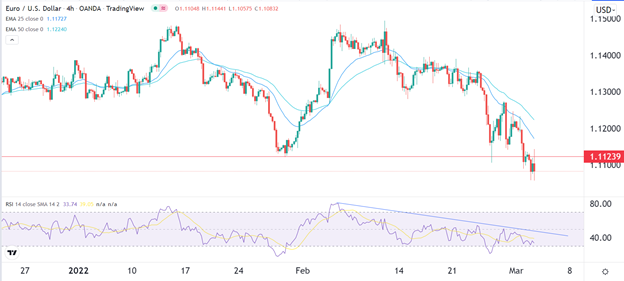Bearish View
- Sell the EUR/USD pair and set a take-profit at 1.100.
- Add a stop-loss at 1.1150.
- Timeline: 1-2 days.
Bullish View
- Set a buy-stop at 1.1115 and a take-profit at 1.1165.
- Add a stop-loss at 1.1025.
The EUR/USD pair continued its downward trend after the strong European inflation data and after the Federal Reserve chair hinted that rate hikes were coming. The pair is trading at 1.1095, which is slightly above this week’s low of 1.1058.
Fed to Move Carefully
In a congressional testimony on Wednesday, Jerome Powell hinted that the Fed will start moving this month. That was interpreted to mean that the bank will deliver a 25 basis point rate hike in its March 16th meeting.
The goal of the rate hike will be to help the country manage the soaring inflation. Recent data showed that the American consumer price index rose to 7.5% in January, the highest level since the 1980s. This performance was blamed on the rising energy prices and the ongoing supply chain challenges.
Sadly, the situation has worsened in the past few weeks because of the crisis in Ukraine. Airlines are charging higher fares because of the bans on airspace. Shipping companies are also increasing their costs. Most importantly, energy prices have gone parabolic, with Brent soaring to above $110 per barrel.
The same inflation trend is happening in Europe. On Wednesday, data by Eurostat showed that the headline and core inflation rose to 5.8% and 2.8%, which were record highs. Like in the United States, Eurostat blamed the situation on higher energy costs.
Therefore, analysts are starting to predict a situation of stagflation in the EU and the US. Stagflation is a dangerous situation when high inflation coincides with slow economic growth. In such a situation, it will be difficult for the Fed and the ECB to embrace a more hawkish tone.
The EUR/USD pair will react to the latest US and EU services and composite PMI numbers and US initial jobless claims data.
EUR/USD Forecast
The EUR/USD pair has been in a strong bearish trend in the past few days. It managed to move below the key support level at 1.1123, which was the lowest level on January 28th. It also moved below the 25-day and 50-day moving averages while the Relative Strength Index has been in a bearish trend.
Therefore, there is a likelihood that the pair will continue moving in a downward trend in the near term. If this happens, the next key support level to watch will be at 1.100.


